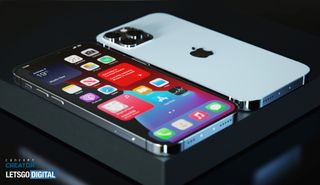
Chinese manufacturer BOE has reportedly entered the Apple supple chain and will produce displays for the upcoming iPhone 13.
This comes after BOE failed validation tests for the iPhone 12, forcing Apple to continue ordering from Samsung and LG.
- iPhone 12 review
- Which phone wins? Galaxy S21 Plus vs. iPhone 12 Pro
- Plus: Spotify HiFi could finally make me pay for lossless music streaming — here’s why
The news comes way of Taiwanese publication Economic News Daily, as interpreted by Macrumors. BOE is apparently working with touch panel manufacturer General Interface Solution (GIS), which is part of the Hon Hai Group, to manufacturer OLED displays that meets Apple's standards. The goal is not only to pass Apple's verification tests, but to also have a high enough yield rate.
The production yield is the percentage of good panels out of the total produced. Reportedly, when tasked with making iPhone 12 displays, BOE could only achieve a yield rate of 20%, far too low to satiate demand by Apple.
If the report does turn out to be true, then BOE will be able to supply OLED panels for both refurbished iPhone 12 models and the upcoming iPhone 13. According to Economic News Daily, BOE's displays are now "closer to that of major South Korean manufacturers." Given Apple's high measure of quality, closer may still not be good enough. Of course, Apple will likely continue ordering displays from both Samsung and LG, the two leading makers of OLED displays for mobile devices.
Manufacturing displays for iPhones may also become more difficult, as rumors suggest Apple will be opting for 120Hz LTPO technology. This is the same type of display currently found on the Samsung Galaxy S21 Ultra and the rumored OnePlus 9 Pro.
And given that Apple has now overtaken Samsung as the world's leading smartphone seller, finding more manufacturing partners will be critical in keeping up with demand.
Sign up to get the BEST of Tom’s Guide direct to your inbox.
Upgrade your life with a daily dose of the biggest tech news, lifestyle hacks and our curated analysis. Be the first to know about cutting-edge gadgets and the hottest deals.
If BOE does enter Apple's manufacturing pipeline with slightly worse displays than that of LG or Samsung, this could create a meta market with the iPhone 13. It's possible that the most persnickety Apple fans will actively seek out units made with LG or Samsung displays, forcing those models to surge in demand.
This is already the case for other electronics that have multiple manufacturing partners. Many who are desperately Googling where to buy Nvidia GeForce RTX 3080 still refuse to buy from manufacturers like Zotac, which has built a reputation for producing subpar cards. And the Nintendo 3DS community, for example, has figured out which models give users the highest quality IPS panels. Of course, those 3DS units ask the highest selling prices.
Apple's embrace of BOE is curious, especially after CEO Tim Cook testified in Congress last year condemning the use of slave labor. Following a question from Representative Ken Buck of New York, Cook said, "let me be clear, forced labor is abhorrent." But according tot he Australian Strategic Policy Institute, BOE, along with many other companies, have been alleged in using forced labor from the imprisoned and persecuted Uighur Muslim minority.
BOE sources some of its displays from Highbroad Advanced Material, which has allegedly used forced labor. Either Apple is deciding to look the other way on this matter, or BOE has cleaned up its manufacturing pipeline to ensure that production is slave labor free.
Apple has lobbied against the Uyghur Forced Labor Protection Act, which would require U.S. companies to require that its manufacturing lines do not use coerced labor from the Muslim region of Xinjiang.
Canada recently voted to recognize China's treatment of Uighurs as Genocide. Both Canada and the UK have announced steps to ban the import of goods made by forced labor in Xinjiang. If investigations prove that BOE, or other Chinese manufacturers in Apple's supply chain, use Uighur labor, then Tim Cook could have a major problem on his hands.
Imad is currently Senior Google and Internet Culture reporter for CNET, but until recently was News Editor at Tom's Guide. Hailing from Texas, Imad started his journalism career in 2013 and has amassed bylines with the New York Times, the Washington Post, ESPN, Wired and Men's Health Magazine, among others. Outside of work, you can find him sitting blankly in front of a Word document trying desperately to write the first pages of a new book.
Most Popular


